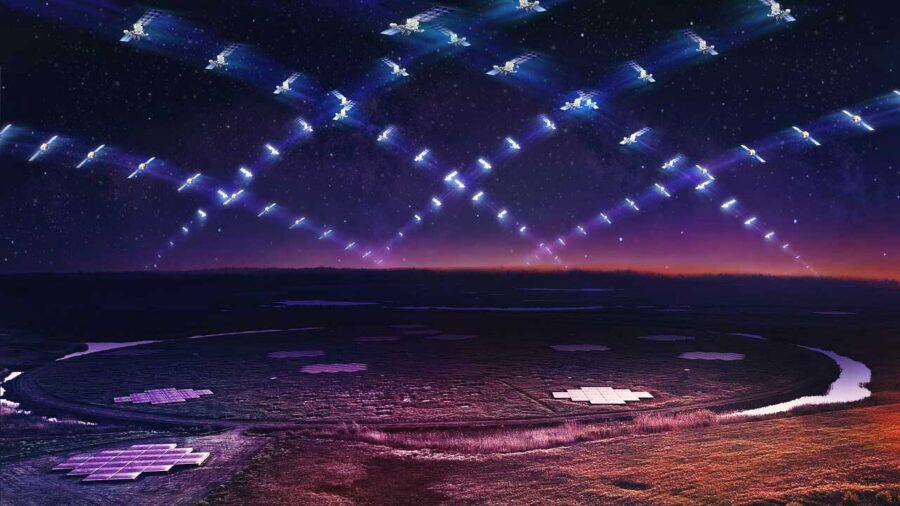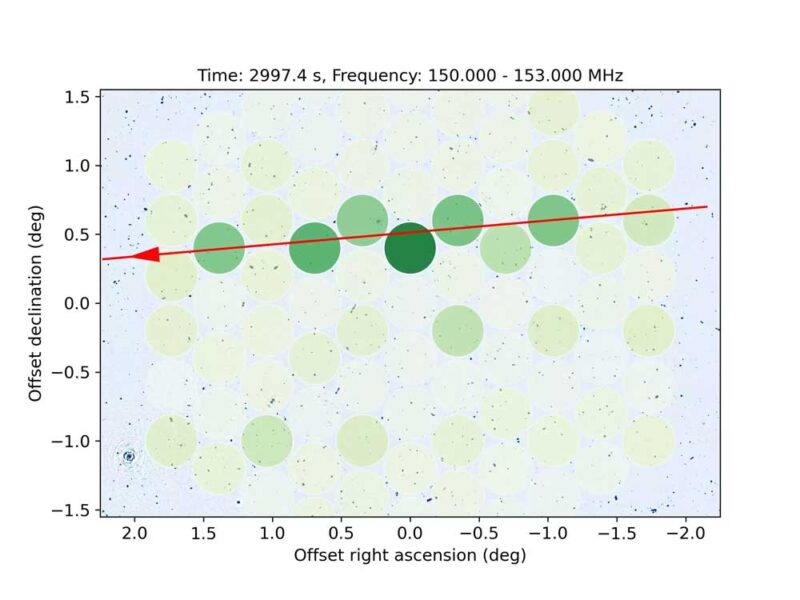Satellites’ leakage radiation, now detected for the first time, may become a major problem for radio astronomy, as “megaconstellations” keep on growing.

Daniëlle Futselaar
Astronomical radio sources, while intrinsically intense, are also far away. What little of their signal reaches Earth is therefore really faint: A single mobile phone on the surface of the Moon would outshine all but the very brightest of them.
Communication signals of Earth-orbiting satellites are much stronger but are by regulation limited to certain wavelengths. They’re also known to radio astronomers, who can filter them out. However, leakage radiation may result in artificial signals at unintended wavelengths. Leakage typically comes from human activity on the ground, but with the number of satellites literally skyrocketing, astronomers are becoming concerned about the effect from space. Now, a team has announced the first detection of this electromagnetic interference from satellites.
“Leakage radiation from artificial satellites as a possible interference first appeared in our minds only about two years ago,” recalls Benjamin Winkel (Max-Planck Institute for Radio Astronomy, Germany, and Committee on Radio Astronomy Frequencies, France). “Back then, nobody knew how strong such an effect would be, and if this was more than just a theoretical problem.”
So Winkel, together with a couple of colleagues from other institutions associated with the Square Kilometre Array Observatory (SKAO), decided to have a look. They used the core antennas of the Low-Frequency Array (LOFAR) in The Netherlands to look for signals from satellites in SpaceX’s Starlink constellation. There were about 2,100 Starlinks in orbit when these data were taken; now there are more than 4,000.
What they found did not quell their fears. Of a total of 68 observed satellites, 47 were detected at frequencies between 110 and 188 MHz. This leakage radiation is well below the 10.7 to 12.7 GHz radio frequencies used for the downlink communication signals. Federico Di Vruno (SKAO and the Committee on Radio Astronomy Frequencies, France), Winkel, and their colleagues have published these results in Astronomy & Astrophysics.

IAU / CPS
Unintended radiation isn’t exactly a surprise. “Every electric device generates leakage radiation,” explains team member Gyula Józsa (also at Max Planck Institute for Radio Astronomy, Germany, and the Committee on Radio Astronomy Frequencies, France). “There is nothing you can do to prevent this, except to influence the strength of those signals.”
Indeed, every gadget in your room that uses electricity, every circuit in your computer or phone, works as a tiny antenna, emitting some extra electromagnetic radiation. Manufacturers take care to ensure that this radiation doesn’t interfere with other devices (or even with the device itself), but there is no reasonable way to eliminate it altogether.
The same is true for electronics in orbit. “Compared to communication signals, what satellites emit as leakage radiation is typically 1 million times weaker,” Winkel explains. “However, for us radio astronomers, this is still strong enough; it’s brighter than most of the astronomical sources we’re observing.”
When looking at the Starlink satellites, the team was able to follow their radio signals as they traversed the sky, showing that most of the radiation came from the satellites themselves, rather than reflections of other radio sources. (One specific frequency originated from a strong space-surveillance radar located in France, which reflected off of some of the satellites.)
Benjamin Winkel
The leaked signals the team detected are much stronger than any individual satellite would be allowed to be while still complying with regulatory thresholds. However, the regulations imposed by the International Telecommunication Union (ITU) only apply to intentional radio emissions.
The leakage problem is not limited to Starlink. Any operating satellite will emit some kind of leakage radiation. What’s changing is the numbers — more satellites in the sky increases the chance that one will cross the relatively narrow field-of-view of radio telescopes on the ground.
“Usually, we just eliminate data that has been contaminated by a satellite from further processing,” says Józsa. “The more this happens, the more observation time we lose.” For time-dependent observations, this can mean losing critical information. For example, astronomers could lose detections of mysterious fast radio bursts (FRBs) — extremely strong radio emissions that last seconds at most.
Even more troubling may be weaker, unidentified signals that hide in the underlying noise, says Józsa, which might lead to erroneous results when typical methods for noise reduction are employed. Leakage radiation also becomes more prominent at lower frequencies, an expanding area for radio astronomy research. Observatories designed specifically to detect these frequencies, such as LOFAR, the Long Wavelength Array in New Mexico, or the low-frequency part of SKA to be built in Australia, are most likely to be affected.
Technical solutions can only mitigate — not solve — the problem. Any attempt to do so would require the help of satellite operators, but such cooperation would at this point be entirely voluntary. Leakage radiation, however strong it might be, doesn’t violate any rules: “From the radio astronomer’s perspective, unintentional electromagnetic radiation is currently not well regulated for satellites and spacecraft,” the research team writes.
So far, the researchers have only obtained a one-hour “snapshot” of one type of satellite using one telescope. They found that the radio signal varied from satellite to satellite, with some not showing up at the observed frequencies at all. Follow-up observations within the coming year will give a more global picture of how much leakage radiation Starlink satellites generate.
But these first results already demonstrate the need for action, Józsa concludes: “We believe that the early recognition of this situation gives astronomy and large constellation operators an opportunity to work together on technical mitigations pro-actively, in parallel to the necessary discussions to develop suitable regulations.”
 0
0









Comments
You must be logged in to post a comment.